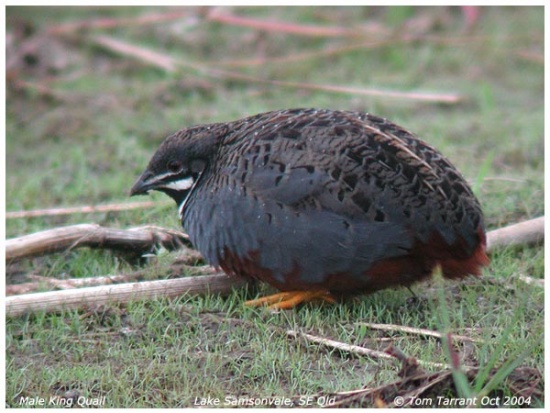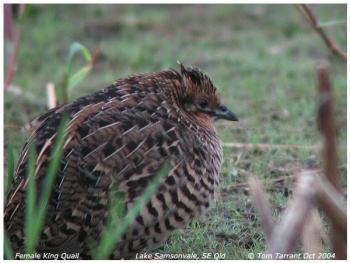m (→External Links: removed BFTV link) |
|||
| (12 intermediate revisions by 5 users not shown) | |||
| Line 1: | Line 1: | ||
'''Alternative names: Chinese Painted Quail, Asian Blue Quail, King Quail''' | '''Alternative names: Chinese Painted Quail, Asian Blue Quail, King Quail''' | ||
| − | [[Image:Blue-breasted_Quail.jpg|thumb|550px|right|Male | + | [[Image:Blue-breasted_Quail.jpg|thumb|550px|right|Male <br />Photo by {{user|Tom+Tarrant|Tom Tarrant}}<br />Lake Samsonvale, South-eastern [[Queensland]], October 2004]] |
| − | ;[[:Category: | + | ;[[:Category:Synoicus|Synoicus]] chinensis |
| + | ''Excalfactoria chinensis'' | ||
==Identification== | ==Identification== | ||
| − | + | [[Image:168kiqu0401.jpg|thumb|350px|right|Female<br />Photo by {{user|Tom+Tarrant|Tom Tarrant}}<br />Lake Samsonvale, South-eastern [[Queensland]], October 2004]] | |
| + | 12–15 cm ( 4¾-6 in)<br /> | ||
| + | *Black bill | ||
| + | *Yellow to orange legs and feet | ||
| + | *Short, dark brown tail | ||
| + | '''Male''' | ||
| + | *Dark brown | ||
| + | *Slate blue-grey breast | ||
| + | *Rust chestnut-red belly | ||
| + | *Black throat patch surrounded by a white band and bordered by a black stripe | ||
| + | *Black eye stripe<br /> | ||
| + | '''Female''' | ||
| + | *Brown | ||
| + | *Rust-brown belly and breast<br /> | ||
==Distribution== | ==Distribution== | ||
| − | [[India]], [[Sri Lanka]], | + | [[Image:28330910096 5da3af18a6 c.jpg|thumb|350px|right|Male with chick, Nominate Subspecies <br />Photo by {{user|SeeToh|SeeToh}}<br />Pulau Punggol Barat, [[Singapore]], July 2016]] |
| + | [[Asia]] and [[Australasia]]<br /> | ||
| + | '''Asia''': [[China]], [[Nepal]], [[India]], [[Andaman Islands]], [[Nicobar Islands]], Eastern and Western [[Himalayas]], [[Sri Lanka]], [[Bangladesh]], [[Taiwan]]<br /> | ||
| + | '''Southeast Asia''': [[Indochina]], [[Myanmar]], [[Laos]], [[Vietnam]], [[Cambodia]], [[Thailand]], [[Malaysia]], [[Malay Peninsula]], [[Brunei]], [[Singapore]], [[Philippines]], [[Borneo]], [[Indonesia]], [[Greater Sundas]], [[Sumatra]], [[Java]], [[Sulawesi]], [[Bali]], [[Timor]], [[Moluccas]]<br /> | ||
| + | '''Australasia''': [[New Guinea]], [[Australia]]: [[New South Wales]], [[Northern Territory]], [[Queensland]], [[South Australia]], [[Victoria]], [[Western Australia]] | ||
==Taxonomy== | ==Taxonomy== | ||
| − | + | Formerly considered [[Dictionary_A-C|conspecific]] with [[Blue Quail]]. Formerly placed in genus ''[[Coturnix]]'' and sometimes placed in genus ''Excalfactoria''. | |
| − | * '' | + | ====Subspecies==== |
| − | * '' | + | There are 10 subspecies<sup>[[#References|[1]]]</sup>: |
| + | *''S. c. chinensis'': [[India]] to [[Sri Lanka]], [[Malaya]], [[Indochina]], south-eastern [[China]] and [[Taiwan]] | ||
| + | *''S. c. trinkutensis'': [[Andaman Islands]] and [[Nicobar Islands]] | ||
| + | *''S. c. lineatus'': [[Philippines]], [[Borneo]], [[Sulawesi]] and Sula Islands | ||
| + | *''S. c. novaeguineae'': Montane forests of [[New Guinea]] | ||
| + | *''S. c. papuensis'': South-eastern [[New Guinea]] | ||
| + | *''S. c. lepidus'': Bismarck Archipelago | ||
| + | *''S. c. colletti'': Northern [[Australia]] ([[Northern Territory]]) | ||
| + | *''S. c. victoriae'': Eastern [[Australia]] ([[Queensland]] to [[Victoria]]) | ||
==Habitat== | ==Habitat== | ||
| − | Wet grasslands. | + | Wet, swampy grasslands, shrublands, paddyfields. |
==Behaviour== | ==Behaviour== | ||
| − | They nest on the ground in hollows | + | ====Breeding==== |
| + | They nest on the ground in grass-lined hollows. The clutch consists of 6-14 eggs, which are olive green to brown and have dark brown spots/blotches. They are incubated for 16-19 days. | ||
| + | ====Diet==== | ||
| + | They are thought to eat grass seeds, vegetation and small insects such as termites and their larvae. | ||
| + | ==References== | ||
| + | #{{Ref-Clements6thAug17}}#Avibase | ||
| + | #Handbook of the Birds of the World Alive (retrieved Nov 2017) | ||
| + | {{ref}} | ||
| + | ==External Links== | ||
| + | {{GSearch|"Synoicus chinensis" {{!}} "Blue-breasted Quail"{{!}} "King Quail" {{!}} "Asian Blue Quail" {{!}} "Chinese Painted Quail"}} | ||
| + | {{GS-checked}}1 | ||
| + | <br /> | ||
| + | <br /> | ||
| − | + | [[Category:Birds]][[Category:Synoicus]] | |
| − | |||
| − | |||
| − | |||
| − | |||
| − | [[Category:Birds]][[Category: | ||
Latest revision as of 11:17, 26 June 2023
Alternative names: Chinese Painted Quail, Asian Blue Quail, King Quail
- Synoicus chinensis
Excalfactoria chinensis
Identification
12–15 cm ( 4¾-6 in)
- Black bill
- Yellow to orange legs and feet
- Short, dark brown tail
Male
- Dark brown
- Slate blue-grey breast
- Rust chestnut-red belly
- Black throat patch surrounded by a white band and bordered by a black stripe
- Black eye stripe
Female
- Brown
- Rust-brown belly and breast
Distribution
Asia and Australasia
Asia: China, Nepal, India, Andaman Islands, Nicobar Islands, Eastern and Western Himalayas, Sri Lanka, Bangladesh, Taiwan
Southeast Asia: Indochina, Myanmar, Laos, Vietnam, Cambodia, Thailand, Malaysia, Malay Peninsula, Brunei, Singapore, Philippines, Borneo, Indonesia, Greater Sundas, Sumatra, Java, Sulawesi, Bali, Timor, Moluccas
Australasia: New Guinea, Australia: New South Wales, Northern Territory, Queensland, South Australia, Victoria, Western Australia
Taxonomy
Formerly considered conspecific with Blue Quail. Formerly placed in genus Coturnix and sometimes placed in genus Excalfactoria.
Subspecies
There are 10 subspecies[1]:
- S. c. chinensis: India to Sri Lanka, Malaya, Indochina, south-eastern China and Taiwan
- S. c. trinkutensis: Andaman Islands and Nicobar Islands
- S. c. lineatus: Philippines, Borneo, Sulawesi and Sula Islands
- S. c. novaeguineae: Montane forests of New Guinea
- S. c. papuensis: South-eastern New Guinea
- S. c. lepidus: Bismarck Archipelago
- S. c. colletti: Northern Australia (Northern Territory)
- S. c. victoriae: Eastern Australia (Queensland to Victoria)
Habitat
Wet, swampy grasslands, shrublands, paddyfields.
Behaviour
Breeding
They nest on the ground in grass-lined hollows. The clutch consists of 6-14 eggs, which are olive green to brown and have dark brown spots/blotches. They are incubated for 16-19 days.
Diet
They are thought to eat grass seeds, vegetation and small insects such as termites and their larvae.
References
- Clements, J. F., T. S. Schulenberg, M. J. Iliff, D. Roberson, T. A. Fredericks, B. L. Sullivan, and C. L. Wood. 2017. The eBird/Clements checklist of birds of the world: v2017, with updates to August 2017. Downloaded from http://www.birds.cornell.edu/clementschecklist/download/
- Avibase
- Handbook of the Birds of the World Alive (retrieved Nov 2017)
Recommended Citation
- BirdForum Opus contributors. (2024) Blue-breasted Quail. In: BirdForum, the forum for wild birds and birding. Retrieved 19 May 2024 from https://www.birdforum.net/opus/Blue-breasted_Quail
External Links
GSearch checked for 2020 platform.1






